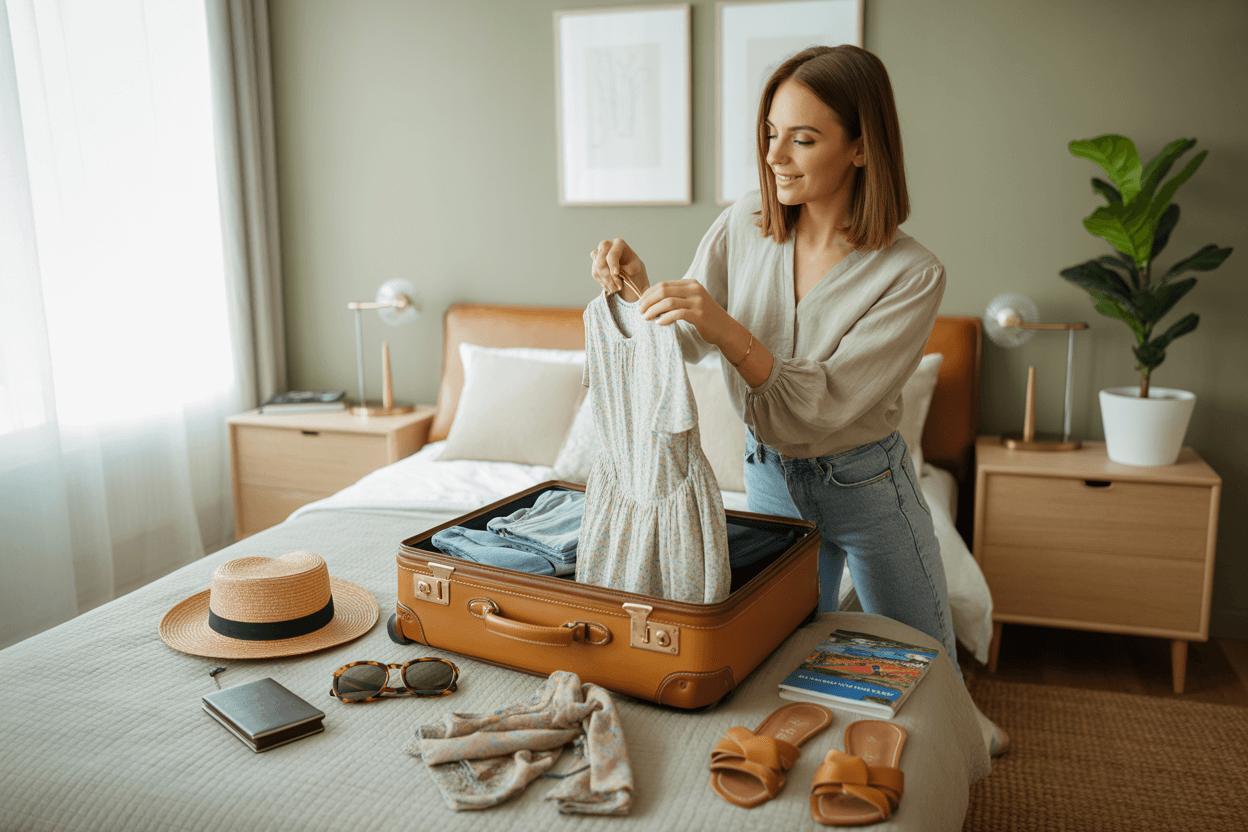Table of Contents
- Introduction to Packing a Suitcase
- Essential Documents and Items
- Clothing Based on Climate and Destination
- Personal Hygiene Products and Medications
- Electronics and Tech Accessories
- How to Optimize Space in Your Suitcase
- Differences Between Carry-on and Checked Luggage
- Expert Tips for Travelers
- Frequently Asked Questions
Packing a suitcase is one of the most crucial moments of any trip, which can determine the success or failure of your experience. Knowing what to pack is not just a practical matter, but an art that is perfected with experience and knowledge of the best organizational strategies.
Every traveler, from the novice to the seasoned globe-trotter, has at least once faced the dilemma of choosing the essential items to bring along. Packing requires a perfect balance between practical needs, personal comfort, and restrictions imposed by airlines.
This comprehensive guide will walk you through all the fundamental aspects of packing, providing you with practical tools and tested tips to optimize every inch of your suitcase. You will learn to distinguish between what is truly essential and what is just unnecessary weight, developing a systematic method that will make every departure more serene and organized.
Essential Documents and Items
The most important category of what to pack undoubtedly concerns personal documents and valuable items. These elements must never be missing and should always be easily accessible throughout the journey.
Identity documents are the first requirement for any travel. Passport, identity card, driver’s license, and health cards must be checked before departure to verify their validity. It is crucial to create digital and paper copies of all documents, keeping them separate from the originals.
As for money and payment methods, diversification is the winning strategy. Cash in the local currency, international credit cards, and prepaid cards offer maximum flexibility. Don’t forget to inform your bank about your travel plans to avoid automatic card blocks.
Essential Documents Checklist:
- Valid passport or identity card
- Tourist visa (if required by the destination)
- Airline tickets and booking vouchers
- Health card and travel insurance
- International driving permit
- Credit cards and cash
- Digital copies of all documents
Clothing Based on Climate and Destination
Choosing what to bring on a trip in terms of clothing requires a careful analysis of the destination’s climate conditions and planned activities. Versatility should be the keyword to maximize possible combinations with the fewest number of items.
For destinations with a temperate climate, the layering technique is a winner. Short-sleeved t-shirts, light shirts, sweatshirts, and jackets allow you to easily adapt to temperature changes. Technical fabrics offer significant advantages: they dry quickly, take up little space, and maintain their properties even after numerous washes.
Footwear deserves special attention in the selection process. Two pairs of shoes are the ideal compromise: a comfortable pair for walking and a more elegant one for special occasions. Remember that shoes take up a lot of space, so choose versatile models that match different outfits.
Clothing Selection Strategy:
- Analyze the weather of the destination for the entire period
- Choose a coordinated color palette
- Prioritize fabrics that do not wrinkle
- Always include a waterproof item
- Pack a complete change of clothes in your carry-on
Personal Hygiene Products and Medications
The selection of personal hygiene products is a delicate aspect of what to pack, as it must balance personal needs and airport regulations. Liquids in carry-on luggage are subject to the 3-1-1 rule: containers of a maximum of 100ml in a 1-liter transparent bag.
For long trips, consider buying travel-sized products or transferring your usual ones into smaller containers. Many hotels provide basic products, but bringing your favorites ensures comfort and continuity in daily routines.
The pharmaceutical kit must be customized based on your medical needs and the characteristics of the destination. In addition to daily medications, always include painkillers, antihistamines, disinfectants, and products for gastrointestinal issues. Keep medical prescriptions and original packaging to avoid customs problems.
Optimal Hygiene and Health Kit:
- Toothbrush and toothpaste
- Travel-sized shampoo and conditioner
- Stick deodorant (more practical than liquids)
- High-protection sunscreen
- Personal medications with prescriptions
- Basic first aid kit
- Feminine hygiene products
Electronics and Tech Accessories
The digital age has radically transformed the list of what to pack, making technology an essential element for most travelers. Planning for electronic accessories requires attention to technical specifications and international regulations.
The smartphone is the most versatile device: phone, camera, navigator, translator, and entertainment center all in one. Make sure you have chargers, power banks, and universal adapters for electrical outlets. A universal adapter is a fundamental investment for frequent travelers.
For photographers, the selection of equipment must balance quality and portability. A compact camera or an action camera can excellently replace bulky professional equipment for most tourist situations. Don’t forget extra memory cards and waterproof protectors.
Tech Essentials:
- Smartphone with a protective case
- Original chargers and spare cables
- Power bank with adequate capacity
- Universal adapter for electrical outlets
- Quality headphones or earbuds
- Camera or action cam
How to Optimize Space in Your Suitcase
The art of optimizing space is the difference between an expert traveler and a beginner. Knowing the right techniques to organize what to pack can double the useful capacity of your luggage without increasing its weight and size.
The rolling technique, which consists of rolling clothes instead of folding them, can reduce the space occupied by clothing by up to 40%. Packing cubes revolutionize internal organization, allowing you to categorize items and compress them effectively.
Utilizing empty spaces is an advanced strategy: socks and underwear can be placed inside shoes, chargers in internal pockets, fragile items wrapped in softer clothes. Every inch of the suitcase must have a specific purpose.
Advanced Optimization Techniques:
- Technical rolling to maximize space
- Using vacuum-sealed bags for down jackets
- Packing cubes for categorical organization
- Utilizing pockets and hidden spaces
- Strategic layering from heavy to light
Differences Between Carry-on and Checked Luggage
Understanding the differences between carry-on and checked luggage is fundamental to strategically deciding what to pack and where to place each item. Airline regulations significantly influence these decisions and vary between companies and routes.
Carry-on luggage must contain everything that might be needed during the flight and in the first few hours after arrival. Documents, essential medications, a change of clothes, and electronic devices should never be checked in. The standard dimensions are generally 55x40x20 cm, but always check with your airline.
The checked suitcase can accommodate larger and heavier items but must be prepared considering the possibility of loss or delay. Never put valuable items, essential medicines, or important documents in the luggage that will be checked.
Strategic Luggage Distribution:
- Carry-on: essentials for 24h survival
- Checked: main clothing and heavy items
- Never separate: documents and life-saving medications
- Duplicate: chargers and basic hygiene products
Expert Tips for Travelers
The most experienced travelers have developed refined strategies to optimize what to pack through years of practical experience. These professional tips can radically transform your approach to packing.
The “dual-use” rule suggests choosing items that can serve multiple purposes: a sarong can be a towel, blanket, beach towel, or light garment. An elastic band can act as a belt, luggage strap, or support for electronic devices.
Mental preparation is just as important as physical preparation. Creating a personalized checklist and testing it on short trips allows you to perfect the system. Many experts recommend doing a trial packing one week before departure to identify any problems or forgotten items.
Secrets of Professional Travelers:
- Invest in quality luggage with multi-directional wheels
- Always carry a foldable bag for shopping
- Use the coordinated “minimal wardrobe” technique
- Photograph the contents of your suitcase for checking
- Keep an emergency kit always ready

Frequently Asked Questions
How far in advance should I start packing?
Start packing at least a week before departure for long trips, 2-3 days for short trips. This allows you to wash specific clothes, buy missing items, and reflect on your choices without rushing.
What is the ideal weight for a suitcase?
For checked luggage, stay under 20kg for European flights and 23kg for intercontinental ones, leaving room for souvenirs. Carry-on luggage should not exceed 8-10kg for ease of transport.
How to avoid forgetting important items?
Create a personalized checklist and use it systematically. Organize items by category and check each group before closing the suitcase. The night before, mentally review all the activities of the trip.
What to do if the suitcase is too full?
Apply the 80% rule: fill the suitcase only to 80% of its capacity. Eliminate unnecessary duplicates, choose lighter fabrics, and consider leaving space for purchases during the trip.
Is it better to bring many clothes or wash them during the trip?
For trips longer than a week, it is more practical to bring clothing for 5-7 days and plan for washing. This reduces weight and volume, leaving space for souvenirs and local purchases.
Mastering the art of what to pack transforms every trip from a source of stress into a pleasant and organized experience. The strategies and tips presented in this guide will lead you towards greater awareness and efficiency in packing.
Remember that a perfect packing strategy develops with experience: every trip is an opportunity to perfect your personal system. The time invested in planning your luggage pays off greatly in terms of comfort, safety, and peace of mind throughout the journey.
With these tools and knowledge, you are ready to face any destination with confidence, knowing you have everything you need for an unforgettable and trouble-free travel experience.
Oh, one important thing… Read other important articles on the subject:
- Essential items;
- What to pack for a beach trip;
- What to pack for a vacation in an apartment;
- What to do before leaving for a trip;
- What to bring when traveling with children.
Thank you for reading our page on the documents needed to travel to Tunisia, and here are a few reminders:
- Essential items
- What to pack in your suitcase to go to the beach
- What to Pack for an Apartment Vacation
- What to do before leaving on a trip
- What to bring when traveling with children
.





